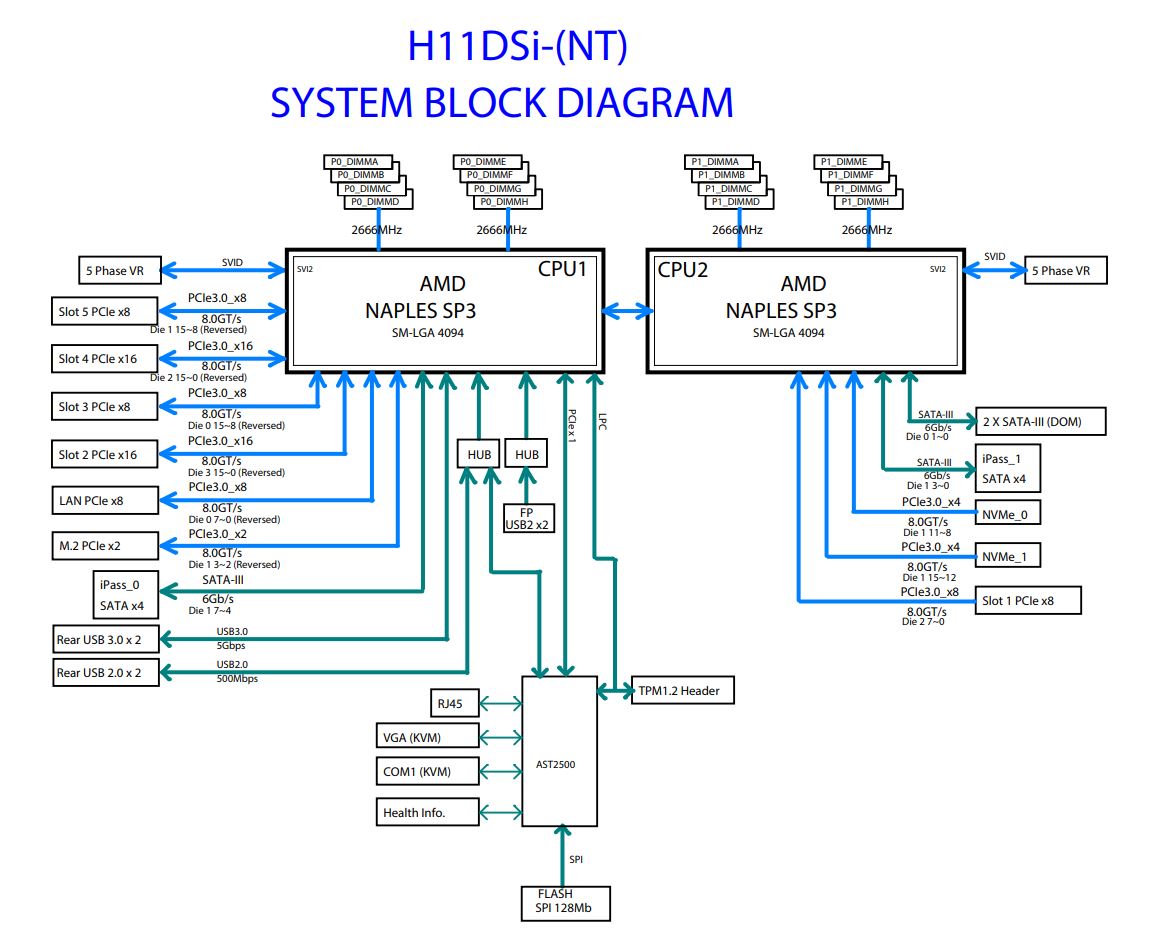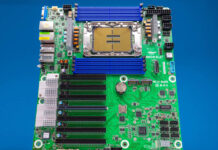As a feature we often get requested for, we wanted to take a second and look at the block diagram for the Supermicro H11DSi-NT before concluding with our final thoughts.
Supermicro H11DSi-NT Block Diagram
With the AMD EPYC architecture, block diagrams matter to many buyers. This is because each AMD EPYC socket is comprised of four pieces of silicon, each is its own NUMA node. Here is what the overall block diagram looks like:

Key here is that the two Oculink NVMe ports are attached to CPU2 die 1. That means that one should get excellent performance between NVMe devices attached to those ports. It also means that if the second CPU is not installed you will lose a PCIe x8 (Slot 1) along with both NVMe drives and six of the SATA ports including the two SATA DOM ports. Our recommendation is to always install two CPUs in this platform if possible.
Final Words
Overall, the Supermicro H11DSi-NT performed well in our testing, equivalent to other dual socket AMD EPYC servers in the lab. We tried a range of CPUs from the low-end AMD EPYC 7251 set to a pair of the AMD EPYC 7601 top bin SKUs.
Some readers may ask which we would recommend, the H11DSi-NT or the Supermicro H11DSi. Given the relatively close pricing, we prefer the H11DSi-NT for future proofing with 10GbE. At the same time, if you are using 25/40/50/100GbE or SFP+ in your infrastructure, the H11DSi can provide cost savings.
If you are looking for a dual socket AMD EPYC platform, in a standard E-ATX form factor, then this is perhaps the top solution in the market today. It has a myriad of features. Some closely match what Supermicro does on the Intel side. For example, Supermicro uses the same BMC and IPMI tooling as well as features like the SATADOM power SATA ports and the Oculink NVMe drive connectors. That is great since one is likely to deploy AMD and Intel alongside one another in this generation. Keeping a common set of features means that the Supermicro H11DSi-NT is an easy platform for ISVs and VARs to deliver to their customers without any major modifications to their systems or the way they do business.
As a drop-in replacement for customers who want AMD EPYC, the Supermicro H11DSi-NT is a perfect example of how to deploy EPYC in the channel. In our next article on this motherboard, we are going see it in the context of a full system, the Supermicro 4023S-TRT server. Stay tuned to STH for more.




699 for this motherboard…That’s NOT bad at all.
Shame the CPUs are still $1k/each.
Doesnt matter when ram prices are sky high :/
I have one of these in shipment. In order to keep costs minimal however, I only bought one 7281 CPU and 4 RDIMMs. I intend to add additional hardware in time. Meanwhile, your article points out how critical the positioning of hardware is on the board. In addition I have an AIC Optane SSD, and an M2 SSD. I am a noob with server-class hardware and Epyc, and I would greatly appreciate it if you would recommend what slots to plug things into.
@rollin Look at the block diagram supported on the third page oft the review and you will know which slots to use when there is only one cpu equipped.
I’m so tired of this market. AMD launch EPYC marketing the 128 lanes capability, and until now i never saw any motherboard that give us at least 7 pci-e x16. Even threadripper that is capable at 64 lanes the motherboards only have 2 pci-e x16, because that’s the number of pci-e found on Intel parts.
But now that scalable has 48 lanes supermicro launch a 6 pci-e x16 motherboard, the X11DPG-QT.
isn’t amazing?
When not nvidia fu**ing the entire market to make their products look better(because without it everyone will see that they are not) is Intel following the leader.
Is hard to be a reasonable consumer this days, unless you cover the nose and swallow everything that this guys throw in the market.
I have puchased this and am currently running one CPU only. I have had no luck connecting the IPASS sata ports 0-3 to the backplane of my supermicro case. I can’t get any hard drives to show up. Any ideas?
Any progress on this? I just purchased this mother board and a pair of Supermicro CBL-SAST-0508-02 50CM INTERNAL MINI-SAS TO MINI-SAS HD w/SB 30AWG cables to go from the IPASS sata ports to the backplane, now I’m wondering if I will have same problems as you :-(
I’m also having trouble with Centos 7.5, I no on Supermicro site they OS compatability matrix shows only 7.3 and so far a 7.3 “minimal” installation seems to be working fine.
Trying to get drivers working for Vega 56 AMD GPU card on this motherboard – work in progress…
Are there any plans of supermicro for dual SP3 board with 4GPU support?? WHo knows?